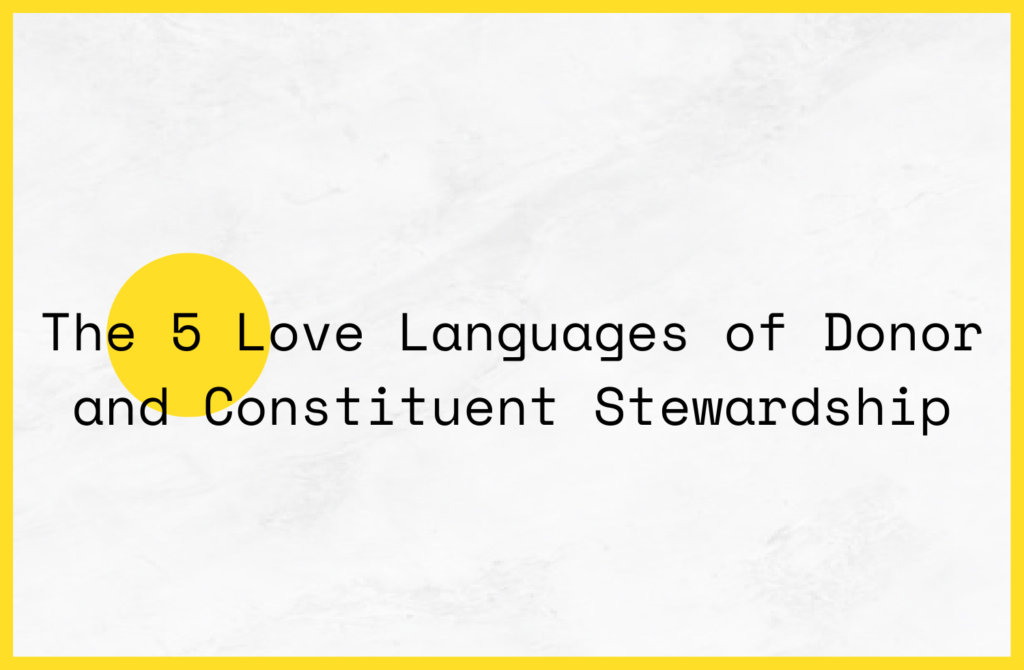Have you heard about the Five Love Languages?
The book outlines five general ways in which we express and experience love: words of affirmation, acts of service, quality time, gift-giving, and physical touch. These principles can be applied to any relationship – how we relate to children, colleagues, friends. These same approaches can be applied to donor and constituent stewardship.
Showing donors gratitude, appreciation, and love is both the right thing to do and an impactful way to cultivate relationships that will benefit the organizational bottom line. Donors are human and their connection to the causes is a very human one. We want to spend time and feel committed to those who make us feel good and positive, appreciate us, and see us.
So how do we apply the 5 love languages to how we steward and cultivate donors? Let’s apply each one of the five love languages to donor stewardship.
Words of affirmation express appreciation and value, in fundraising we call it being donor-centric. Your support makes a difference. Thank you for what you do. Because of you. These are all words of affirmation to include in your interactions with donors. Words of affirmation are the backbone of any donor stewardship program worth its salt. A few examples of how this can be applied:
Your support makes a difference. Your gift is impactful. Thank you for what you do. Because of you. People like you.
Consider including these “words of affirmation” strategies in your interactions with donors:
- Send a thank-you letter to your donors reiterating the impact of their support
- Turn contribution receipts into an impactful touchpoint
- Plan a thank-you phone calls campaign incorporating words of affirmation into the calling scripts
- Include affirmations in your fundraising appeals
- Look for opportunities in every donor interaction and conversation
- Leverage signage and posters
Acts of service in interpersonal relationships may mean washing the dishes without being asked, helping, making life a little easier for a loved one. In thinking about donors, acts of service are about making it easy to be a donor. Acts of service are operational in nature and on their own are unlikely to truly deepen donors’ commitment to the cause. But breakdowns in this area may frustrate donors and create unnecessary tension. Here are a few examples of ways to express appreciation for donors through acts of service:
- Friendly donor services to answer questions and take care of their needs
- Easy and intuitive ways to contribute
- Timely confirmations and receipts
- An easy-to-use donor portal to download receipts and set preferences
- Easy ways to update credit card payments
Quality time, self-explanatory, is impactful but can be a challenge when working with a large direct response audience. Consider segmenting your audience and spend more time engaging priority donors and prospects, while creating experiences that can be scaled up but feel like one-on-one engagement.
- Patiently listening and getting to know your donors – the planned giving crew has this one down
- Major donor visits and one-on-one interactions
- Showing up to support your contributors –frequent interactions with donors often turn into genuine friendships
- Thank-you events – luncheons or mission visits – for exclusive groups of supporters
- An event, virtual or in person, to get an exclusive inside look at the work of the organization
- Opportunities to volunteer in person
- Virtual gatherings to give them an insight into the issue and work they support
- Compelling stories to read or watch can feel like the quality time that connects audiences with the work of the organization
Giving gifts -who does not love a goodie? For some of us, this is extremely meaningful especially when the gift is thoughtful. For nonprofits, it’s important to connect gifts, real or symbolic, to the mission. Although it is not necessarily about providing something of material value, having budgetary limitations may require some creativity.
- Premiums and tchotchkes
- Gifts that connect the donor to the mission – a great example are items hand-made by the very people organization supports
- Holiday cards
- Symbolic gifts – think about paying for naming a star in the sky
- Gifts that convey belonging such as bumper magnets or social photo frames
- Fun downloadable badge to symbolize support and achievement
Physical touch is simpler in interpersonal relationships, but please do not go around hugging donors you only just met. Let’s flip this a little bit and think about the physical bucket as showing the impact and appreciation in tangibles ways.
- Video or a slide show spotlighting mission in action
- Photos and updates from sponsored children or families
- Visits to see mission in action up close (this one bleeds into quality time too)
- Recognition walls and bricks with donors’ names
Does your organization need help to develop a sound stewardship strategy and bring it to life? Please reach out to discuss how we can work together or book a strategy session to get started.


Brighten Up!
Let’s keep in touch. Please sign up and we will share with you periodic updates, thought pieces, conversations, and ideas.